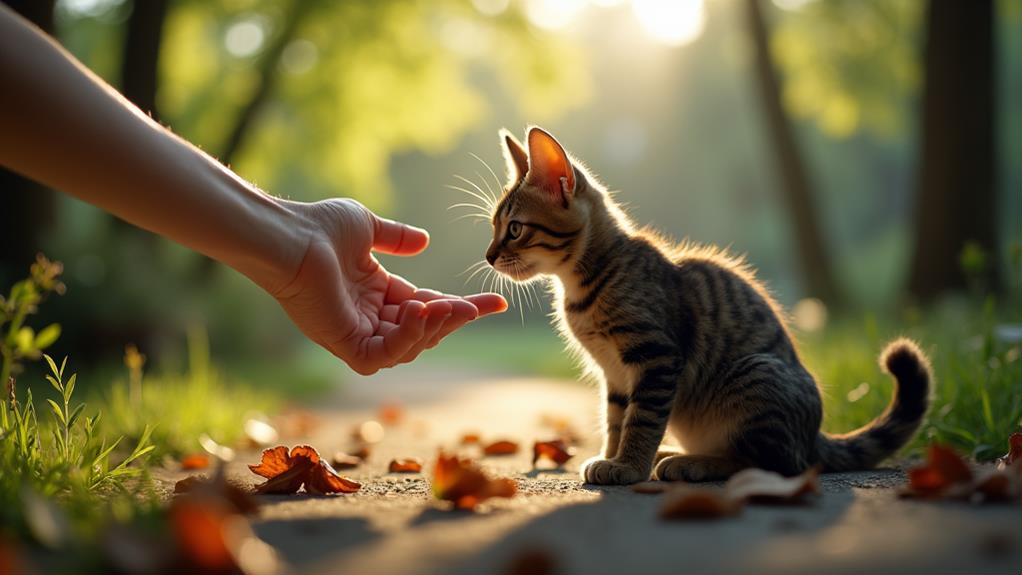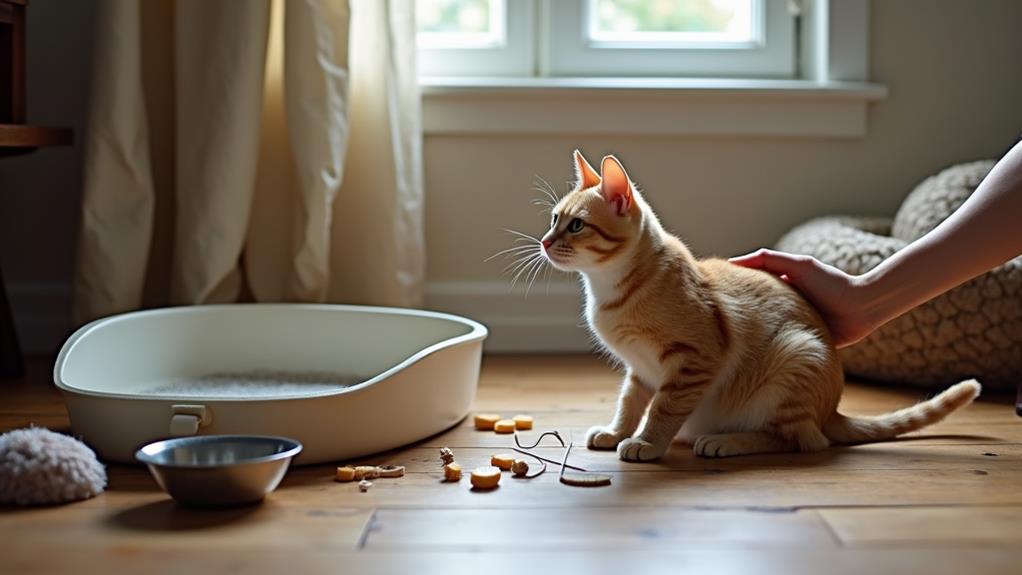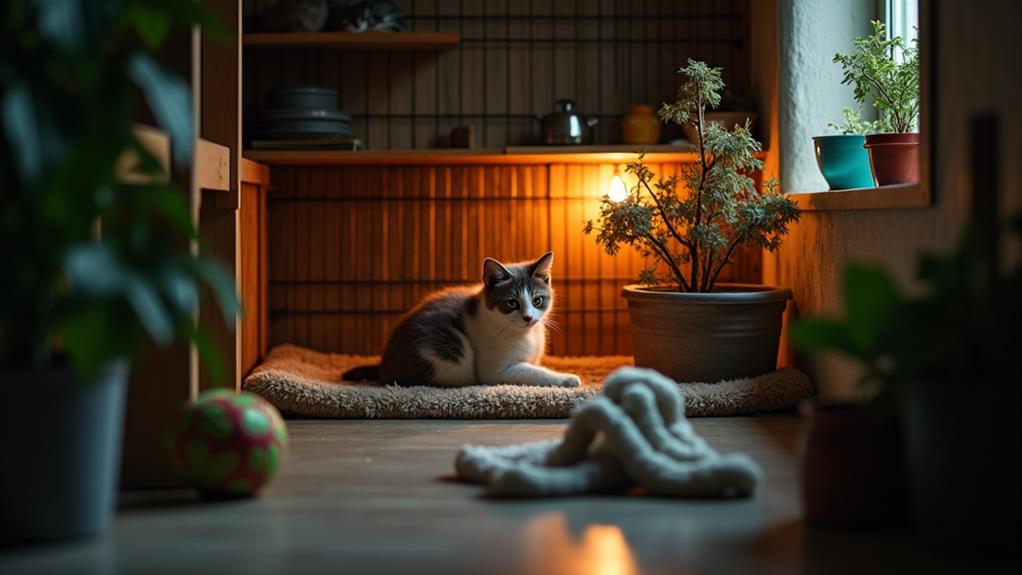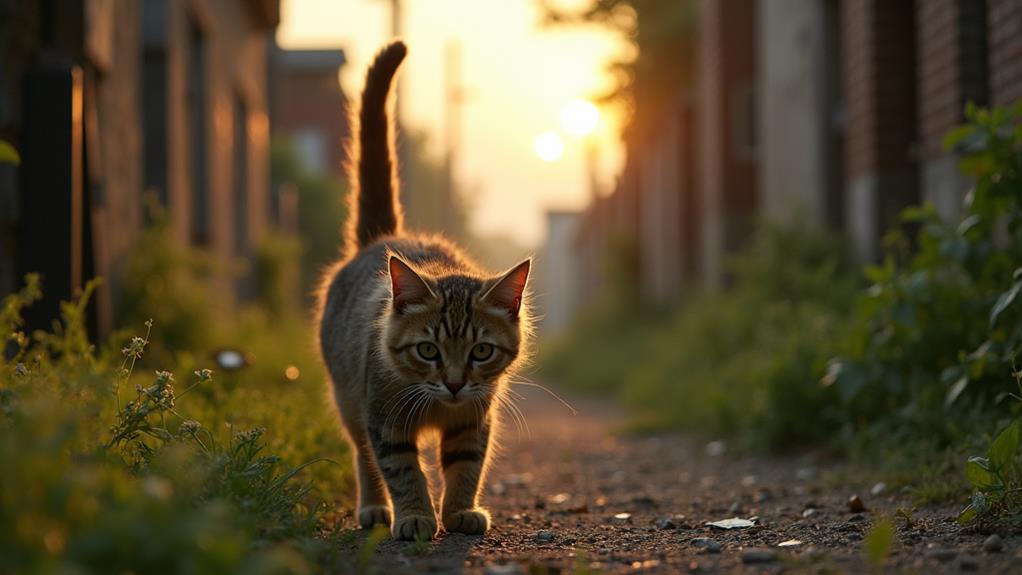How to Socialize a Feral Cat: Building Trust and Reducing Fear

To socialize a feral cat, start by creating a quiet, safe environment equipped with necessities like food, water, and a litter box. Use familiar scents and gentle music to promote calmness. Introduce food as positive reinforcement, using treats to build associations with safety. Observe your cat's body language closely, looking for signs of comfort, and use slow blinks and gentle glances to avoid appearing threatening. Establish consistent routines and engage in interactive play to foster trust. Patience is key, as progress can be slow. Investigate more to uncover techniques that can help transform your feral cat's life.
Understanding Feral Cat Behavior
Grasping the intricacies of feral cat behavior is essential to successfully socializing them. Feral cats often approach humans with wariness, driven by their survival instincts. Building trust with these cats requires a keen understanding of their unique personalities and timelines. Some might take months to adjust, and that's perfectly normal. Patience becomes your greatest ally in this process, as rushing the process could hinder progress.
Recognizing feline body language is crucial. Feral cats communicate discomfort through signals like swishing tails, dilated pupils, and hissing. These signs mean you should give them space and time to feel secure. Avoid direct eye contact, as it can be perceived as a threat. Instead, use sideways glances and gentle blinks to show you mean no harm.
Food is a powerful tool in gaining their trust. Offering it consistently can demonstrate reliability, helping to slowly bridge the trust gap. Watch for subtle shifts in their behavior; a relaxed posture or a softer gaze might indicate growing comfort. Each positive interaction sets the stage for deeper trust. By respecting their boundaries and demonstrating patience, you'll gradually foster a bond with your feral cat.
Preparing a Safe Environment
To effectively build a relationship with a feral cat, creating a safe and welcoming environment is key. Start by setting up a quiet, cat-proofed room where the cat can safely adjust. Equip this space with crucial supplies like food and water bowls, a litter box, and different hiding spots. These hiding spots will offer the cat refuge, helping lower its stress levels and improving its quality of life. Confirm these areas are away from high-traffic zones to provide a sense of security, making it easier for the cat to relax during feeding and bathroom breaks.
Introduce familiar scents, such as worn clothing, to create comfort and ease anxiety. This will facilitate more positive interactions as the cat associates these scents with safety. Limit access to unfamiliar people and pets to maintain a calm atmosphere and reduce stress, further promoting a sense of safety. Carefully monitor the environment for potential hazards, securing small spaces and removing dangerous objects to improve the cat's safety and well-being.
Building Trust Gradually

Building trust with a feral cat is a gradual process that requires patience and understanding. Start by creating a safe environment where the cat can investigate at its own pace. Respecting its boundaries is vital for building trust. Here's how you can help:
- Positive Reinforcement: Gradually introduce food as a positive reinforcement. Hand-feeding treats can be an effective way to show the cat that you're a source of safety and nourishment.
- Observe Body Language: Pay close attention to the cat's signals. Relaxed postures and slow blinks indicate comfort, suggesting readiness for closer interactions and eventually physical contact. This helps in gauging when the cat feels secure enough to engage.
- Consistent Routines: Establish consistent daily routines, such as regular feeding times and maintaining a quiet presence. This predictability fosters a sense of safety important for building trust over time.
Incorporate calming strategies like Feliway pheromones or soft music to create a soothing atmosphere. This can make the space more inviting and reduce stress. Interactive play can further encourage positive interactions, building a bridge of understanding. Remember, every step you take with patience brings you closer to a trusting bond.
Effective Socialization Techniques
Many find that effective socialization techniques can transform a feral cat's life, bringing them closer to humans in a safe and nurturing way. The initial step is to establish a consistent feeding routine. Providing food and water at the same time daily helps build trust, as feral cats thrive on predictability due to their survival instincts. It may take months, but this routine creates a sense of security.
Incorporate calming strategies like Feliway pheromones or gentle cat music. These elements reduce stress, making the environment more inviting for socialization. When introducing food as a motivator, hand-feeding treats in a calm setting encourages the cat to associate humans with positive experiences. It's a crucial thing to remember—let the cat set the pace, respecting its comfort levels.
Play is another effective technique. Using wand toys or engaging in interactive play sessions lets the cat participate while reinforcing positive associations with your presence. Pay attention to the cat's body language. Carefully observe for signs of comfort or distress, and adjust interactions accordingly. By doing so, you'll facilitate trust-building effectively, ensuring the cat feels safe and understood throughout the process.
Maintaining Health and Hygiene

When socializing a feral cat, maintaining health and hygiene is essential to guaranteeing its well-being. Start by scheduling regular visits to the vet's office. These check-ups are important for monitoring general health and administering vaccinations against FeLV and FIV, which help prevent serious health issues. By keeping these appointments, you confirm your cat is on track to becoming a healthy member of a loving home.
Next, focus on proper hygiene in their environment. Consistently clean litter boxes to prevent parasite infestations and reduce stress for your cat. A dirty litter box can lead to health issues, so maintaining cleanliness is significant. Here's a simple checklist:
- Clean litter boxes regularly.
- Wash food and water bowls often.
- Remove toxic plants or objects from their space.
Long-term Commitment Strategies
Socializing a feral cat is an expedition best traversed with dedication and patience. It's a long-term commitment that requires consistent daily interactions to slowly foster trust. By feeding and spending quiet time near the cat, you create opportunities for connection. Establishing a predictable routine is essential; it helps the cat feel secure, as they begin to expect your presence and care. This routine not only reduces anxiety but also strengthens the trust-building process over time.
Patience is your greatest ally. Progress can be slow and may not follow a linear path. Setbacks aren't failures—they're chances to learn and adapt. Regularly assess the cat's comfort levels and tweak your approach based on their responses. This adaptability encourages gradual engagement and maintains a positive relationship.
To further improve your efforts, consider joining support groups or online communities. These platforms offer valuable insights, shared experiences, and encouragement from others on similar paths. The collective wisdom gained can be immensely helpful in traversing the long-term commitment of socializing a feral cat. Remember, every small step forward is a victory in this rewarding process.




